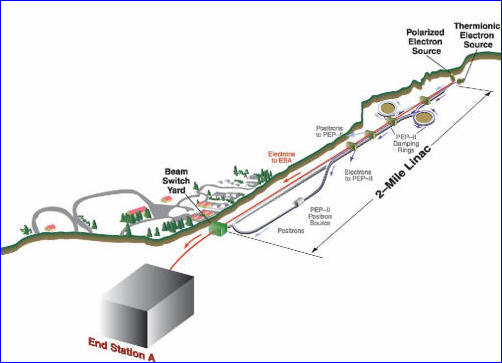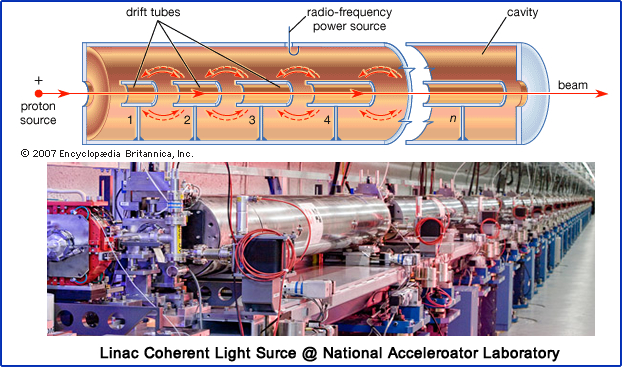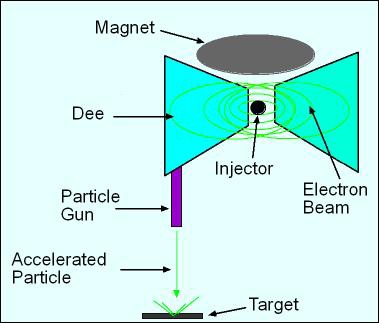- Instead of generating radioisotopes via fission stable compounds can be made radioactive by bombarding a target element with some type of particle
- In order to penetrate a nucleus of an atom a significant energy must be given to the appropriate paritcle
- Protons, deuteron, alpha particles (and other charged particles) require upto 109 eV of energy to penetrate a target element's nucleus.
- Types of hydrogen
- This process causes an increase in the atomic mass number making the atom unstable (radioactive)
- Particle accelerators is one method used to accomplish this process. There are two types under discussion: linear accelerators and cyclotrons
- Linear accelerator (Linac)
- The above accelerator has a single 2 mile track that causes particle acceleration. At the "End Station A" the beam of particles strikes the target material with protons, electrons, or some other type of particles
- In smaller accelerators there is a series of cylinders (drift tubes) lined up together which pulses electrostatic field between each tube increasing the energy of the particle, pushing and pulling and moving the particle forward
- More on the process
- As an example, a proton starts in the first cylinder (drift tube) and it is attracted to the opposite end by a negatively charged field
- As the particle approaches and passes the end of the first cylinder the charge reverses, pushing the particle away
- As it enters the second cylinder, the opposite end is negatively charged attracting the particle and the process repeats itself
- This occurs many times
- During this process the particle continues to gain speed as it passes from one cylinder to the next
- At the end of the linear accelerator it has gained significant energy that allows it to penetrate the nucleus of an atom
- At the end of the linear accelerator high velocity protons hit a target of material, enter the atom, which alters its atomic structure
- Cyclotron - The basic explanation (next lecture discusses a cyclotron in more detail)
- Basic principle, a cyclotron works in a similar fashion to a linear accelerator and a diagram of this unit is identified below
- A proton enters the injector (protons, electrons, deuterons)
- The proton is then attracted to the first Dee by creating a negative charge at the end of the Dee
- As the "proton" reaches the end of the Dee it becomes positive, pushing the proton away, giving it additional energy (in eV)
- The Dee in which the particle jumps to starts increasing its acceleration
- Every time particle reaches the gap the negative charge becomes positive causing the particle to jump across the gap. This oscillation may occur up to 200 times giving the particle enough energy to penetrate the nucleus of the target material
- A magnet keeps the proton in a circular path as it jumps from one Dee to the other
- As the particle continues to gain eV the path continues to widen
- Once a certain speed is reached the particle leaves the cyclotron and hits the target material at high velocity
- Protons then enter the atoms of the target material changing its atomic structure
- The cyclotron vs. linear accelerators
- Cyclotrons are smaller than linear accelerator and may be best suited for a hospital type facility
- Maximum energies for cyclotrons are ~30MeV, where linear accelerators can reach 200 MeV (pending its size)
- Usually carrier-free radioisotopes are produced
- A disadvantage with this type or radioisotope is that it usually has a short half-live
- An example of a cyclotron facility and a diagram of the unit can be found at http://cyclotron.tamu.edu/
- Advance to the lecture entitled Cyclotrons used in PET for a more comprehensive understanding

Click to enlarge - https://www-project.slac.stanford.edu/e158/images/LINAC_ESA.jpg
To see the areal map click here

http://kids.britannica.com/elementary/art-59696/Schematic-diagram-of-a-linear-proton-resonance-accelerator-The-accelerator
